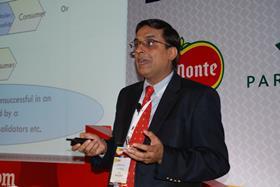
The agricultural landscape in China and India is highly complex, CHIC Group CEO Edward Zhu and advisor of Indian-based consulting company Entrepreneur Raman Ahuja explained to delegates at the Asia Fruit Congress on 3 September.
Both China and India have a significant need to educate farmers on appropriate growing practices, safe pesticide use, as well as difficulties with fragmented, small-scale farms rather than the large-scale farming that would be better suited to producing enough fruit and vegetables to satisfy population demand.
“Large-scale farming has never been in place in China, so the demand and training simply isn’t here,” said Zhu. “Businesses looking to invest here would have to bring that themselves. Aggregating land here is highly difficult so that also isn’t really an option.”
“There are 120m farmers in India, with smaller land holdings averaging 2-3 acres (0.81-1.21ha),” Ahuja told delegates. “There is a low skill base among traditional farmers – they have had little training. Alignment is basically non-existent.”
Alongside the impediments to growing fresh produce, each country has significant difficulties once it has been harvested. In China, these difficulties are in distributing the produce; in India, the complex retail market is impeding business development
“Cold chain and logistics in China are somewhere between nascent and non-existent,” conceded Zhu.
“Foreign retail businesses have been having extremely tough times in India,” added Ahuja. “Expectations have been raised but the situation has changed very little in the last ten years. Germany first opened Metro in October 2003 and they had many problems getting business going. In December 2012 the government tried to combat the stagnation and opened up to allow 51 per cent foreign direct investment in multi-brand retail (100 per cent in single-brand), but it is still extremely difficult for people involved in business there.”
Despite these obstacles, Zhu and Ahuja both emphasise the strong demand for fresh produce in each of their countries which their large populations and typical diets.
“Fruit and vegetables in particular are a fundamental part of the Chinese diet,” said Zhu. “There is enormous demand for safe, nutritious fresh produce.”
“40 per cent of the population in India is vegetarian and the other 60 per cent eat a lot of vegetarian food,” said Ahuja. “So there is huge demand for fruit and vegetables.”
Alongside these factors, urbanisation and disposable income is increasing in both countries. China has seen the average household’s disposable income quadruple between 2000 and 2012, and in India, 175m rural homes will have an annual income of US$2,500-15,000 by 2032.
“This is a huge potential market to tap into in a community that spends nearly a third of its budget on food,” said Ahuja.



